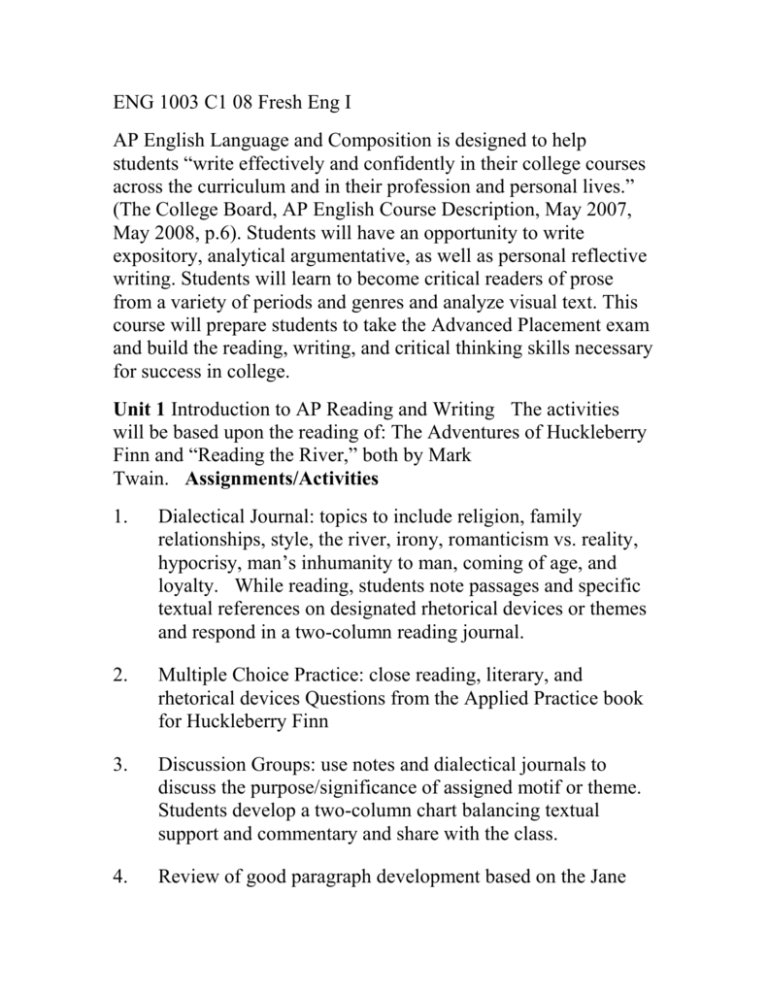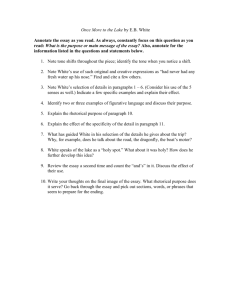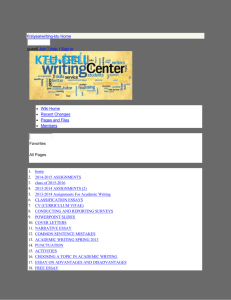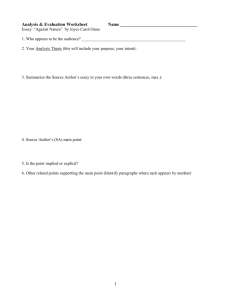
ENG 1003 C1 08 Fresh Eng I
AP English Language and Composition is designed to help
students “write effectively and confidently in their college courses
across the curriculum and in their profession and personal lives.”
(The College Board, AP English Course Description, May 2007,
May 2008, p.6). Students will have an opportunity to write
expository, analytical argumentative, as well as personal reflective
writing. Students will learn to become critical readers of prose
from a variety of periods and genres and analyze visual text. This
course will prepare students to take the Advanced Placement exam
and build the reading, writing, and critical thinking skills necessary
for success in college.
Unit 1 Introduction to AP Reading and Writing
The activities
will be based upon the reading of: The Adventures of Huckleberry
Finn and “Reading the River,” both by Mark
Twain.
Assignments/Activities
1.
Dialectical Journal: topics to include religion, family
relationships, style, the river, irony, romanticism vs. reality,
hypocrisy, man’s inhumanity to man, coming of age, and
loyalty.
While reading, students note passages and specific
textual references on designated rhetorical devices or themes
and respond in a two-column reading journal.
2.
Multiple Choice Practice: close reading, literary, and
rhetorical devices Questions from the Applied Practice book
for Huckleberry Finn
3.
Discussion Groups: use notes and dialectical journals to
discuss the purpose/significance of assigned motif or theme.
Students develop a two-column chart balancing textual
support and commentary and share with the class.
4.
Review of good paragraph development based on the Jane
Schaffer writing model
5.
Objective test and battle card
6.
Huck Finn essay based on released AP prompt: this essay
will serve as a foundation to measure writing growth,
identify areas of strength and weakness, as well as an
introduction to the scoring rubric used throughout the year.
7.
Introduction to close reading and prose analysis: “Reading
the River” questions and discussions focusing on point of
view, analogy, personification, parallelism, repetition, word
choice, imagery, irony, figurative language, syntax, structure,
and tone.
Unit 2 Grammar Review
Focus on coordination, subordination,
sentence variety, modifiers, and sentence
combining
Assignments/Activities
1.
Grammar presentations: individual student review, with
visual aids and original examples, particular grammatical
elements or skills
2.
Identify and use as models effective sentence structures from
texts or recent publications
3.
Apply these strategies effectively in a brief focused writing
assignment
Unit 3 Library Orientation
Focus on research and documentation
skills Assignments/Activities
1.
Each student will draw a topic from a pool of current issues
and locate five sources of pertinent information. Students
must locate a book, periodical, reference book, Internet
source, and one other source.
2.
Students will collect bibliographic information from these
sources and compile a Works Cited page following MLA
format.
Unit 4 Style Analysis/Tone
Introduction to prose analysis
focusing on the author’s tones, purpose and rhetorical devices used
to develop these tones, particularly diction, detail, imagery, and
syntax “The Rattler,” excerpt from “The Road of a Naturalist” by
Donald Culross Peattie excerpt from “Narrative of the Live of
Frederick Douglas”
excerpt from Chapter One The Scarlet
Letter
Assignments/Activities
1.
Explicit instruction using graphic organizers on determining
the tone of “The Rattler” and the author’s method of
development, based on Jane Schaffer Style Analysis model
2.
Guided practice or small group instruction with the Frederick
Douglas passage
3.
Close reading and informal written prose analysis from
Chapter One of The Scarlet Letter. Students will determine
the author’s tone and show how he develops it through
rhetorical devices including diction, detail, imagery,
symbolism, repetition, and syntax.
Unit 5 Comparison/Contrast
“The General History of Virginia”
John Smith
“Of Plymouth Plantation” William Bradford
The
Scarlet Letter Nathaniel Hawthorne
The Crucible Arthur
Miller
“The Most Sublime Spectacle on Earth” John Wesley
Powell “Seeing” Annie Dillard
Assignments/Activities
1.
Close reading of Smith’s and Bradford’s accounts; chart
similarities and differences using a graphic organizer
2.
Guided comparison/contrast essay: introduction on
incorporating textual support, topics and methods of
comparison/contrast, tone, purpose, and organization
Revision for textual support, commentary, and paragraph
development
3.
Guided reading questions and dialectical journal for The
Scarlet Letter: topics including the scaffold scenes, nature
and color imagery, symbolism, character development and
motivations, and historical context
4.
The Scarlet Letter battle card and objectives test
5.
Class presentation from dialectical journals of themes and
stylistic devices
6.
Informal writing: Students research McCarthyism and
interview older adults about life in the 1950’s.
7.
The Crucible: class reading and discussion
8.
Watch the movie The Crucible (Twentieth Century Fox
1996). Discuss Miller’s dramatic conversions,
comparing/contrasting it with the text
9.
The Crucible objective test and battle card
10. Formal Essay: compare/contrast The Crucible and The
Scarlet Letter Students will work through all steps of the
writing process—prewriting using a graphic organizer,
writing, revising and editing, and publishing. Students will
compare/contrast common motifs, historical context, and
rhetorical devices used to develop theme and tone. Revision
will focus on specific textual references, paragraph
development, sentence variety, and any other common areas
of weakness.
11. Guided reading and questions concerning theme, tone, and
purpose of the Dillard passage and Powell passage: particular
focus on point of view, statistics, sound imagery, color
imagery, movement imagery, repetition, parallelism,
allusions, and figures of speech
12. Compare/contrast Powell and Dillard passages in a chart:
students will analyze the author’s attitude about nature, their
rhetorical strategies, organizational techniques
Unit 6 Persuasions
Focus on determining the author’s purpose,
tone, and persuasive devices
Study of methods of persuasion
including the logical, emotional, and ethical appeals Instruction on
the elements of an effective persuasive essay including refutation
“The Declaration of Independence” Thomas Jefferson
“Speech in
the Virginia Convention” Patrick Henry
from “Letters from an
American Farmer” Michel-Guillaume Jean de Crevecoeur “Letter
from Birmingham Jail” Martin Luther King,
Jr.
Assignments/Activities
1.
Close reading/annotation of passages to determine the
author’s purpose, theme, and tone and his use of persuasive
rhetorical devices including repetition, details, word choice,
organization, anaphora, and allusions
2.
Analysis of logical, emotional, an ethical appeals;
identification of organizational patterns and refutations
3.
Evaluation of pictures and a cartoon relevant to the Civil
Rights movement and discussion of their persuasive
techniques
4.
Write a letter to the editor about an issue of personal or local
interest
5.
Formal essay based on “Letters from an American Farmer”
analyzing de Crevecoeur’s attitude toward the Europeans
and Americans
6.
Analysis of sample essays that would score high on an AP
style prompt: focus on clear comprehension of the passage,
skillful integration of quotations, sophisticated wording, and
thoughtful commentary with textual support
Unit 7 To Kill a Mockingbird Assignments/Activities
1.
Dialectical Journal: topics including daily life in Maycomb,
prejudice/cruelty, Atticus’s influence, Boo’s kindness, and
the trial of Tom Robinson
2.
Brief informational report based on allusions and elements of
historical significance
3.
Timed persuasive essay modeled after AP prompt
4.
Prose analysis from short selected passages to determine
tone, purpose, and use of rhetorical devices
5.
Multiple choice AP test question practice and review of
literary and rhetorical strategy terminology
6.
Objective test and battle card
Semester Exam
Comprehensive Semester Exam
Students will define and identify
context literary and rhetorical terms
Essay based on common
themes found throughout the semester’s readings
Prose analysis
chart: brief selection to determine tone, theme, and stylistic devices
used to support them.
Unit 8 Exposition Annotated Bibliography
Focus on independent
research skills, synthesis of information, evaluation of sources, and
documentation skills
Assignments/Activities
1.
Locate fifteen sources of information about a selected topic
from our school library, local library, local community
college library, or online sources
2.
Develop focus questions to guide research
3.
Make source cards and note cards
4.
Compile notes into an annotated bibliography using MLA
format
5.
Compile a formal outline
6.
Revise for sentence variety, content, and format
7.
Publish
Unit 9 Their Eyes Were Watching God
Focus on description,
imagery, figurative language, and symbolism
Assignments/Activities
1.
Discussion of the Harlem Renaissance and historical context
2.
Dialectical Journal: commentary on ten significant quotes
3.
Guided reading questions by chapter
4.
Figurative Language: identify and evaluate similes,
metaphors, onomatopoeia, apostrophe, personification,
hyperbole, and other effective figures of speech
5.
Small group prose analysis: tone developed by the author’s
diction, figurative language, and detail
6.
Timed essay modeled from AP prompt
7.
“My Last Duchess” Robert Browning: Compare the dramatic
monologue with the voice of Janie, protagonist of Their Eyes
Were Watching God
8.
Objective test and battle card
Unit 10 Poe’s Use of Language to Create a “Single Effect” “The
Fall of the House of Usher”
“The Raven”
“The Bells”
Assignments/Activities
1.
Close reading of “The Fall of the House of Usher”
particularly noting foreshadowing, descriptive detail,
narrator’s perspective, imagery, syntax, and allegory
2.
Analyze poems using TPCASTT and graphic organizers:
note and evaluate Poe’s use of language to create a single
effect, his use of the sound devices of language, and his use
of figurative language
3.
Objective test
4.
Write a descriptive paragraph of dominant impression using
figurative language, descriptive detail, and imagery
Unit 11 Sentence Combining/Syntax
Focus on sentence variety
and syntax as a rhetorical device Assignments/Activities
1.
Small group/individual exercises in combining sentences
using coordination, parallel structure, and subordination
2.
Discussion of periodic and cumulative sentences, models
from noted authors, and application to individual writing
Unit 12 Reflective Essay
Focus on non-fiction, which uses
significant personal anecdotes Tuesdays with Morrie Mitch
Albom
“The Cut” Bob Greene
“Mother Tongue” Amy
Tan
Assignments/Activities
1.
Read “The Cut,” noting Greene’s organization, use of
examples, tone, and purpose
2.
Discuss Greene’s perspective of an everyday event and its
significance
3.
Read “Mother Tongue,” focusing on Tan’s use of language to
classify and define
4.
Evaluation and discussion of three advertisements and their
use of different types of language: determine the speaker,
audience, situation, and advertisers’ purpose
5.
Read Tuesdays with Morrie
6.
Students choose an adult who has significantly influenced
their lives and complete twelve brief informal writing
assignments while reading Albom’s memoir.
7.
Use the notes and reflections to write a memoir, patterned
after Albom’s, about their “Morrie”
8.
Revise for voice, dialogue, and descriptive detail
9. Publish with photos
10. Objective test and battle card
Unit 13 Prose Analysis
Focus on close reading to analyze an
author’s purpose, tone, and rhetorical devices “Walden” Henry
David Thoreau
“The Gettysburg Address” Abraham
Lincoln
“Letter to His Son” Robert E. Lee
“The Minister’s
Black Veil” Nathaniel Hawthorne
Assignments/Activities
1.
Close reading and discussion of an excerpt from “Walden”
2.
Multiple choice AP questions
3.
Quiz
4.
Close reading of “The Gettysburg Address” and “Letter to
His Son”
5.
Concrete detail/commentary chart of rhetorical devices
supporting each theme, tone, and purpose
6.
Close reading of the parable, “The Minister’s Black Veil,”
especially noting symbolism, imagery, detail to create
mood, and irony
7.
Discussion comparing this short story with The Scarlet Letter
8.
Objective Test
Unit 14 Synthesis Essay
Focus on developing a position from
multiple sources Assignments/Activities
1.
Students will be provided with five or six sources of
information including visual images and graphics. As a small
group, they will formulate a thesis and support it from these
sources. They will outline their arguments and present them
for class evaluation.
2.
Students will write a formal synthesis essay using multiple
sources of information, including visual texts, with an
emphasis on documented argumentation rather than mere
paraphrase or summary.
3.
Revision for appropriate documentation, organization, and
textual support
Unit 15 Documentary Narrative
Focus on point of view,
descriptive detail, purpose, and tone Hiroshima John
Hersey
Assignments/Activities
1.
Video clip from the motion picture Pearl Harbor (Buena
Vista 2001) to establish historical context and discuss
perspective
2.
While reading, students will note significant events and
insights for a particular character
3.
Using these notes, students will write a diary of five entries,
using first person point of view, focusing on emotions, sights,
sounds, and smells the particular character encountered—
literally painting a picture with words
4.
Write a eulogy and design a cover depicting the assigned
character. Bind these activities in a booklet.
5.
Reading quiz
6.
Objective test and battle card
7.
Prose analysis of selected passages to determine Hersey’s
tone and methods to develop it
8.
Essay comparing excerpts from Hiroshima, written within
months of the bombing, and D.J. Enright’s Memoirs of a
Medicat Professor, written ten years later. Students will
consider the authors’ perspective, tone, detail, and rhetorical
devices to establish each writer’s response to the bombing.
9.
Students will read examples and write haiku
10. Discuss “Sadako and the Thousand Cranes” and make a
simple origami
Unit 16 Poetry
Focus on linguistic and rhetorical devices to
convey theme, tone, and purpose
Poems of Walt Whitman, Emily
Dickinson, Longfellow, Whittier, Angela de Hoyas, Robert Frost,
Langston Hughes, Carl Sandburg, Paul Laurence Dunbar, Edwin
Arlington Robinson, Edgar Lee Masters, and
others
Assignments/Activities
1.
Class study and analysis of selected poems using TPCASTT
and other reading strategies
2.
Students will choose a poem, research, the author’s life,
TPCASTT the poem, answer guided reading questions, and
explicate the poem for the class.
3.
Students will also create a visual representation of their poem
to illustrate its tone and theme.
Unit 17 AP Language Test Prep Assignments/Activities
1.
Students brainstorm, outline in small groups, and share with
the class responses to released AP prompts
2.
Timed essay using released prompt
3.
Review literary and rhetorical terminology
4.
Multiple choice question practice
Unit 18 Modern Short Stories
Focus on literary
analysis
Authors including Kate Chopin, Edith Wharton, Shirley
Jackson, William Faulkner, Ernest Hemingway, Katherine Anne
Porter, Jack London, Eudora Welty, Flannery O’Conner, John
Updike, Alice Walker, Julia Alvarez, Tim O’Brien, and others
Assignments/Activities
1.
Class study of “The Jilting of Granny Weatherall” to model
close reading
2.
Small group study of a selected short story
3.
Close reading worksheet to guide student analysis of theme,
tone, and literary devices
4.
Reading quiz
5.
Group presentation to include: written plot summary,
concrete detail/commentary chart of stylistic devices to
support theme and tone, visual/graphic display
Battle Cards
Students complete a 5x8 note card for each major work that we
study. This “battle card” will include a plot summary, list and
description of the major characters, point of view, setting, tone,
examples of irony and symbols, theme, explanation of title, and a
memorable quote. These cards are used to review major works for
the AP test.
Vocabulary
In addition to encouraging wide and varied reading to foster
vocabulary development, students will learn new words throughout
the year using the text Vocabulary for Achievement, 6th course.
Skill Builders
We will begin most class periods with a brief proofreading,
editing, usage, sentence combining, or literary term review
activity. We will also examine and evaluate images as text during
these activities. Students keep those skill builders in their
notebooks until the end of each grading period. Students at this
level are expected to have good command of standard written
English and usage; however, we will address common mistakes in
mini lessons as needed.
Scoring Rubric
All essays are scored with a rubric that evaluates
thesis/introduction, concrete details and commentary, consistent
verb tense, point of view, sentence structure and variety,
appropriate grammar and usage, sophistication of word choice,
organization, and transitional devices. Students work through all
steps of the writing process: prewriting, writing, revision, and
publishing. Students have many opportunities to revise/edit their
own papers as well as participate in peer editing.
Textbooks
Carroll, Joyce, ed., et al. Writing and Grammar: Ruby Level.
Upper Saddle River, New Jersey: Pearson Prentice Hall, 2004.
Kinsella, Kate, ed., et al. Literature: The American Experience.
Upper Saddle River, New Jersey: Pearson Prentice Hall, 2005
Richek, Margaret. Vocabulary for Achievement. 6th course.
Wilmington, MA: Great Source, 2005.
Trimmer, Joseph F. A Guide to MLA Documentation. 5th ed.
Boston: Houghton Mifflin, 1999.
Novels and plays:
The Adventures of Huckleberry Finn Mark Twain The Scarlet
Letter Nathaniel Hawthorne
The Crucible Arthur Miller
To Kill
a Mockingbird Harper Lee
Their Eyes Were Watching God Zora Neale Hurston Tuesdays
with Morrie Mitch Albom
Hiroshima John Hersey
Supplementary Materials
Selections from
Applied Practice books: Pre-AP AP version. Austin: Applied
Practice, 2001.
DiYanni, Robert, and Pat C. Hoy, II. Frames of Mind: A
Rhetorical Reader with Occasions for Writing. United States:
Thomas Wadsworth, 2005.
Miller, George, ed. The Prentice Hall Reader. 7th ed. Upper Saddle
River, New Jersey: Pearson Prentice Hall, 2004.
Schaffer, Jane. Style Analysis. San Diego: Jane Schaffer
Publications, 1995. Trimmer, Joseph F. Writing with a Purpose.
13th ed. Boston: Houghton Mifflin, 2001.



![Submission 68 [doc]](http://s3.studylib.net/store/data/008000926_1-fed8eecce2c352250fd5345b7293db49-300x300.png)


